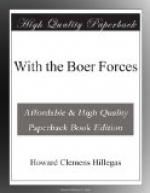One of the primary reasons why the Boer could move more rapidly than the British was the difference in the weight carried by their horses. The Boer paid no attention to art when he went to war, and consequently he carried nothing that was not absolutely essential. His saddle was less than half the weight of a British saddle, and that was almost all the equipment he carried when on a trek. The Boer rider and equipment, including saddle, rifle, blankets, and a food-supply, rarely weighed more than two hundred and fifty pounds, which was not a heavy load for a horse to carry. A British cavalryman and his equipment of heavy saddle, sabre, carbine, and saddle-bags, rarely weighed less than four hundred pounds—a burden which soon tired a horse. Again, almost every Boer had two horses, so that when one had been ridden for an hour or more he was relieved and led, while the other was used. In this manner the Boers were able to travel from twelve to fourteen hours in a day when it was absolutely necessary to reach a certain point at a given time. Six miles an hour was the rate of progress ascribed to horses in normal condition, and when a forced march was attempted they could travel sixty and seventy miles in a day, and be in good condition the following morning to undertake another journey of equal length. Small commandos often covered sixty and seventy miles in a day, especially during the fighting along the Tugela, while after the battles of Poplar Grove and Abraham’s Kraal, and the capture of Bloemfontein, it seemed as if the entire army in the Free State were moving northward at a rate of speed far exceeding that of an express train. The mobility of the Boer army was then on a par with that of the British army after the battle of Dundee, and it was difficult to determine which of the two deserved the palm for the best display of accelerated motion.




